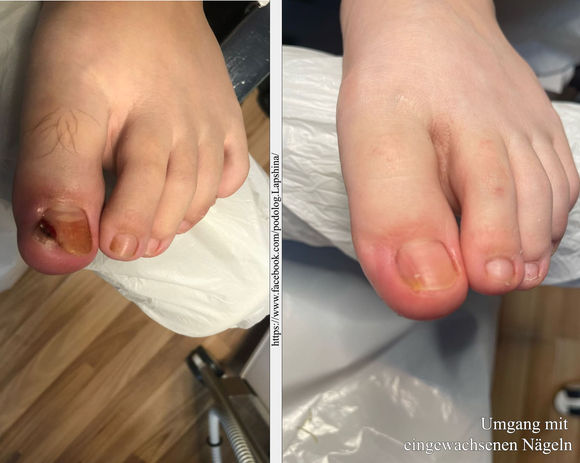PRICELESS EXPERIENCE
On this page, you will find a direct and honest reflection on what I do best - treating foot conditions and nail diseases that impact the lives of my patients every day. These "before" and "after" photos were taken during my practical work in podiatry, where I have helped many individuals find relief and recover from various conditions such as onychomycosis, onycholysis, onychogryphosis, ingrown nails, granulomas, diabetic foot care, and much more.
These visual stories are not just demonstrations of the transformations of the feet I treat; they illustrate the journey toward better well-being, health, self-confidence, and comfort. Each set of images tells the story of identifying the problem, executing a treatment plan, recovery, and prevention. As you browse these examples, remember that behind each photo lies a person who has experienced the discomfort and embarrassment that often accompany podiatric issues. My goal is to provide effective, compassionate treatment that not only addresses the painful and aesthetic aspects of these diseases but also addresses the underlying causes and prevents recurrence.
Therefore, whether you're dealing with a stubborn fungal infection or a painful ingrown toenail, typically accompanied by a granuloma (purulent inflammatory tissue, and sometimes "wild flesh"), know that these cases testify to the resilience of my patients and the effectiveness of the treatment methods I offer. I am proud to provide solutions that truly enhance the quality of life for my patients, day by day, step by step.
DIABETIC FOOT
People with diabetic feet face reduced sensitivity due to nerve damage (neuropathy) and poor blood flow as a result of diabetes. They may not feel minor injuries, increasing the risk of infections and ulcers.
Diabetic foot therapy includes a comprehensive approach to controlling blood sugar levels, regular foot care and monitoring, professional nail care and removal of dead skin, the use of specialized shoes to relieve pressure on the feet, and antibiotic therapy to treat infections.
ALIGNMENT OF THE NAIL PLATE USING A CORRECTION SYSTEM
Treatment of a nail plate that is incorrectly formed and positioned on the nail bed often involves the application of a specialized corrective system/plate/brace to the nail. This device exerts a gentle, continual tension that helps slowly straighten the nail to the correct shape. This method operates on a principle similar to the way dental braces work. It is commonly used for conditions like an ingrown toenail, where the nail curves and grows into the surrounding skin (the periungual folds), leading to pain and a potential for infection that can develop into a recurrent issue such as a granuloma. Factors that contribute to the curvature and misplacement of nails include improper nail care, wearing tight footwear, or a genetic predisposition to such nail problems.
TREATMENT OF AN INGROWN TOENAIL
Ingrown toenails occur when the edges or corners of the nail grow into the skin next to the nail (periungual folds). The flesh surrounding the sides of the nail, known as the nail fold or periungual zone, can become inflamed due to the nail becoming embedded in it. This can lead to pain, redness, swelling, and sometimes purulent infection and, in recurrent cases, the formation of “wild meat”. The main causes are improperly trimmed nails, tight or ill-fitting shoes that put pressure on the toes, as well as nail trauma and a genetic predisposition to crooked nails.
TREATMENT OF ONYCHOGRYPHOSIS
Onychogryphosis, often referred to as "ram's horn nails," is a condition involving the thickening and abnormal curvature of the nails, which may resemble claws or horns.
TREATMENT OF ONYCHOLYSIS
Onycholysis is the detachment of the nail from the nail bed, often starting at the tip and/or sides and progressing toward the cuticle. Here’s a brief description of its causes and preventive measures:
1. Trauma: Frequent tapping, typing, or physical injury can lead to nail detachment.
2. Infection: Fungal or yeast infections can cause the nail to separate from its bed.
3. Skin Conditions: Psoriasis or eczema affecting the nails can contribute to onycholysis.
4. Systemic Illness: Thyroid disorders and other systemic diseases may manifest through onycholysis.
TREATMENT OF ONYCHOMYCOSIS
Onychomycosis, or fungal nail infection, occurs due to the overgrowth of fungi in, under, or on the nail. Here’s a brief description of its causes:
Causes:
1. Fungal Exposure: Direct contact with fungus in damp environments such as public showers or pools.
2. Poor Circulation: Reduced blood flow to the extremities can weaken the body's ability to fight off infection.
3. Age: Elderly individuals are more prone to onychomycosis due to slower nail growth and reduced circulation.
OTHER PROCEDURES
REGULAR FOOT CARE
In this section, I would like to highlight examples from my practice that shed light on some of the foot pathologies encountered and underscore the extensive work performed during consultations to identify, prevent, and treat foot diseases. While my examples may not have mentioned standard regular foot care procedures, my commitment to comprehensive care and effective preventative measures is evident in the illustrated cases. It is also worth noting that clients choose my clinic because of the safety of all the procedures performed here, where strict sterilization and care for the work environment have no compromises. You have already become acquainted with this in more detail on the Sterilization page. Take care of yourselves and be healthy!







































